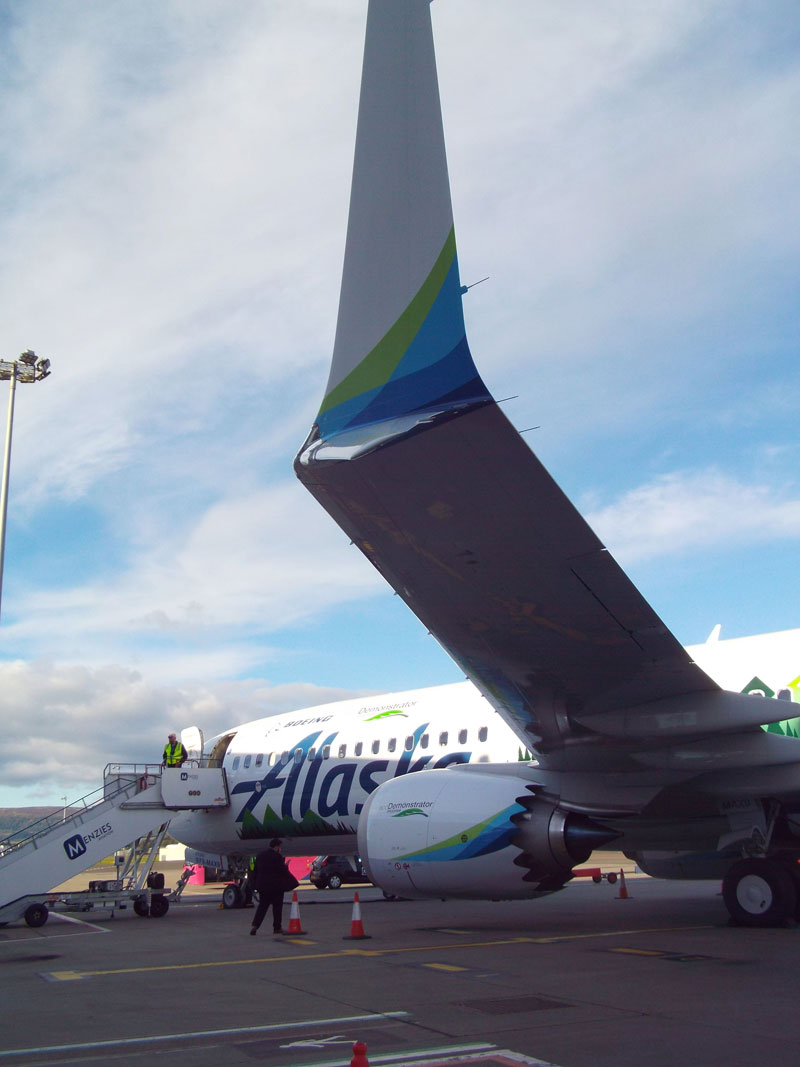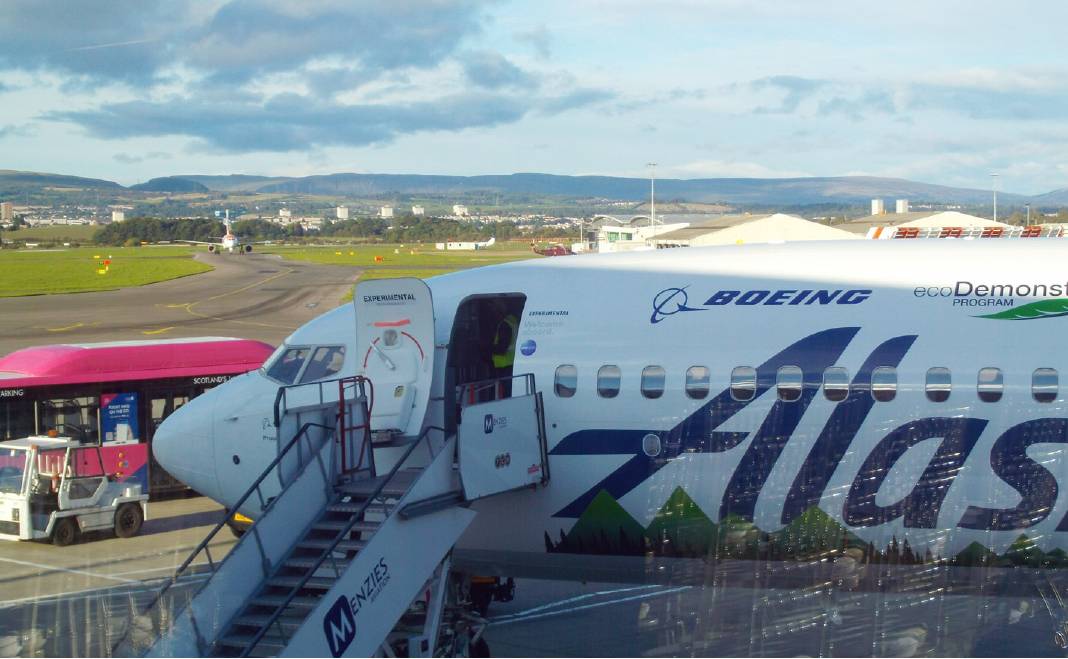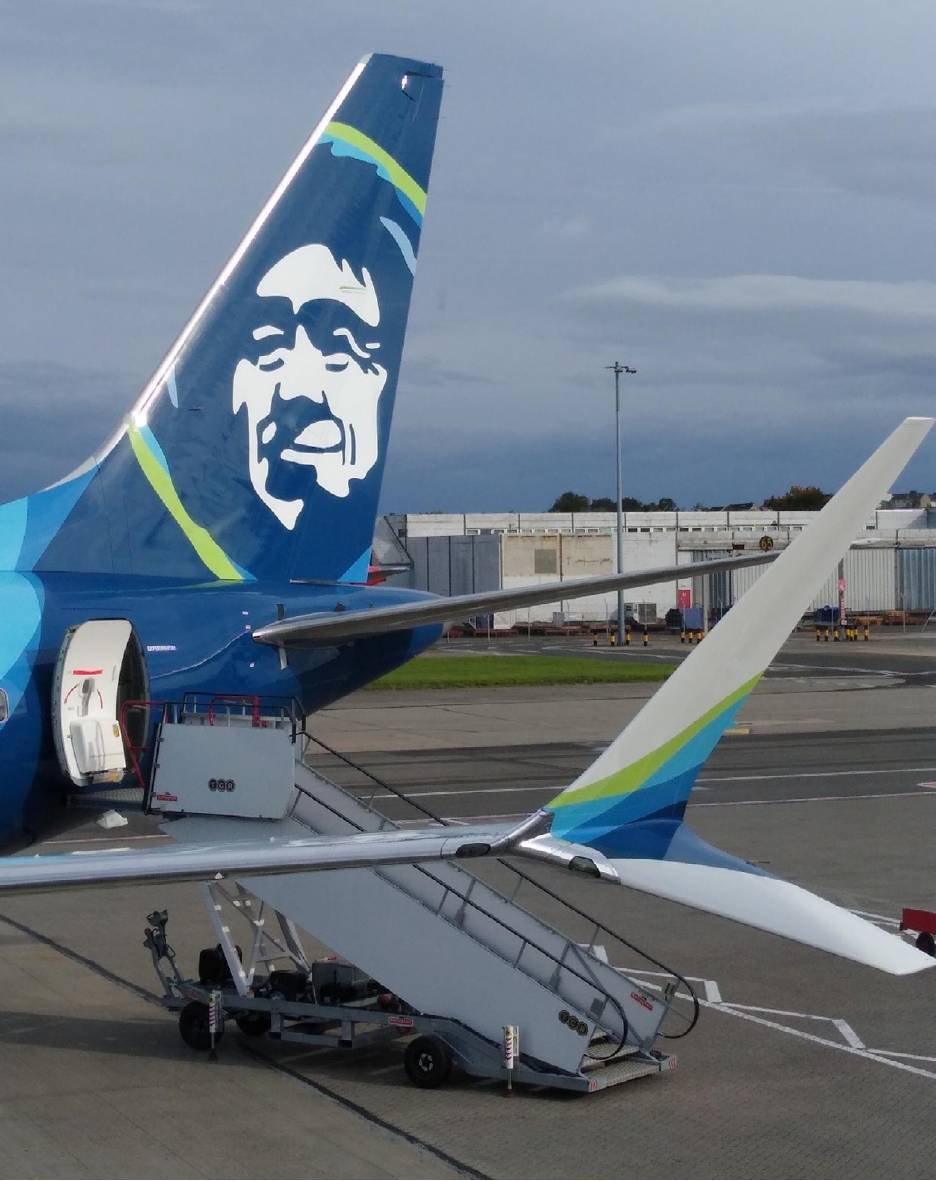AEROSPACE Boeing ecoDemonstrator testbed
Testing sustainable technology
BILL READ FRAeS reports from Glasgow on how Boeing is researching new technologies to improve the environmental efficiency of aircraft and airlines through its ecoDemonstrator programme, which in 2021 is partnered with Alaska Airlines.
In October, Boeing brought its latest ecoDemonstrator aircraft over to Glasgow, the Scottish city where the UK hosted the UN COP26 international climate change conference in November. AEROSPACE was invited to tour the aircraft while it was at Glasgow Airport.
 Boeing has been running its ecoDemonstrator programme for a number of years. Beginning in 2012, Boeing has used eight aircraft as flying test beds to trial a wide variety of different technologies and test them in the air to see if they have potential to be developed into solutions to improve aircraft and airline efficiency, enhance passenger experience and reduce the impact of aviation on the environment.
Boeing has been running its ecoDemonstrator programme for a number of years. Beginning in 2012, Boeing has used eight aircraft as flying test beds to trial a wide variety of different technologies and test them in the air to see if they have potential to be developed into solutions to improve aircraft and airline efficiency, enhance passenger experience and reduce the impact of aviation on the environment.
These have included technologies that reduce fuel use, emissions and noise, as well as incorporating more sustainable materials. Other projects have focused on cabin amenities, such as smart galleys, seats and lavatories that increase airline reliability and the efficiency of fleets and crews.
The ecoDemonstrator programme is run by a small team of engineers and specialists working within the Boeing Commercial Airplanes’ Product Development division. The team is augmented by engineers and researchers from Boeing, together with airlines, suppliers and academia. The team has the motto ‘innovate, collaborate, accelerate’ with the aim of supporting one another to use the test platform to advance innovation for aviation and the constant evolution of new ideas.
The aircraft and technologies used for the first seven EcoDemonstrator programmes are summarised as follows:
2012: 737-800NG (delivered to American Airlines)
14 projects, including:
- Aerodynamic performance of the 737 MAX advanced technology winglet
- Variable area fan nozzle to optimise engine efficiency
- Active engine vibration control
- Regenerative hydrogen fuel cell for aircraft electrical power
- Flight path optimisation for operational efficiency
- Carpets made from recycled materials
- Flying on a blend of sustainable aviation fuel
2014: 787-8 Dreamliner (owned by Boeing)
35 projects, including:
- Aerodynamic and flight control improvements
- Advanced wing coatings to reduce ice accumulation
- Software applications and connectivity technologies to improve flight planning, fuelload optimisation, in-flight routing and landing
- Airborne Spacing for Terminal Arrival Routes (ASTAR) system to help achieve precise spacing between aircraft during approaches
- Touch-screen displays on the flight deck
- Wireless sensors to reduce wiring weight
- Outer wing access doors made from recycled 787 carbon fibre
- First flight using renewable diesel
2015: 757 (owned by the aircraft finance division of Stifel)
20 projects, including:
- Robust wing designs to enable natural laminar flow and improve aerodynamic efficiency, including Krueger shield to protect the leading edge of the wing from insects, ‘bug-phobic’ coatings that can reduce drag from insect residue and active flow control to improve airflow over the rudder
- Flight using 5% blend of renewable diesel
This aircraft was subsequently dismantled with around 90% being reused or recycled.
 Above from left to right: ecoDemonstrator Chief Engineer, Rae Lutters, gives a tour of the aircraft; Test equipment aboard the 737 MAX ecoDemonstrator; iPad apps developed from previous ecoDemonstrator projects provide weather information to pilots to improve fuel efficiency and reduce emissions. All images unless stated: Bill Read/RAeS
Above from left to right: ecoDemonstrator Chief Engineer, Rae Lutters, gives a tour of the aircraft; Test equipment aboard the 737 MAX ecoDemonstrator; iPad apps developed from previous ecoDemonstrator projects provide weather information to pilots to improve fuel efficiency and reduce emissions. All images unless stated: Bill Read/RAeS
2016: E170 (owned by Embraer)
Six projects, including:
- Ice-phobic paint to reduce drag
- Wireless measurement of airflow over the surface of the wing
- Wing slat cove fillers to reduce noise
- Air data measurement system using light distancing and ranging (LiDAR)
- Flown used SAF sourced from Brazilian sugarcane
 2018: 777 Freighter (owned by FedEx Express)
2018: 777 Freighter (owned by FedEx Express)
37 projects, including:
- Surface Operations Collision Awareness System (SOCAS) which uses optical and radar sensors to detect obstacles on the ground
- FLYHT Aerospace Solutions’ Automated Flight Information Reporting System (AFIRS) provides tracking, distress and data-streaming capabilities from flight-data recorders
- World’s first commercial airliner flight flown on 100% sustainable fuel
- Manufacturing by-products reused as fittings replacing titanium alloy (Ti64) with over 75% recycled content
- A laser system to detect clear air turbulence
2019: 777-200 (owned by Boeing)
53 projects, including:
- Small vertical ‘vortex generator’ vanes formed from shape memory alloys extended on take-off and landing to improve aerodynamic efficiency but retracted during flight
- Electronic flight bag application to automatically reroute an aircraft to avoid bad weather conditions
- Operational efficiency project to enable pilots, air traffic controllers and an airline’s operations centre to share digital information to optimise routing
- Self-disinfecting lavatory using ultraviolet light to disinfect all surfaces
- Galleys equipped with sensors to help cabin crews locate catering items faster and enable airlines to better manage inventories using data analytics
- Organic LED displays in the ceiling and on a cabin divider to inform and entertain passengers
2020: 787-10 (owned by Etihad Airways)
Nine projects, including:
- Landing gear modified to be quieter by Safran Landing Systems
- Another operational efficiency project
- Portable ultraviolet wand to disinfect high-touch and hard to clean surfaces, including flight deck control panels
Boeing Commercial Aircraft now incorporate technologies which were evaluated and proven on the ecoDemonstrator programme, including more aerodynamically efficient winglets on the 737 MAX, iPad apps that provide real-time weather and other information to pilots to help improve fuel efficiency and reduce emissions, customised landing approach path information to lower noise and flight deck touch-screen displays and a camera system on the 777X to help pilots avoid ground obstacles.
The 2021 programme
After announcing its partnership with Alaska Airlines in June 2021, Boeing began testing the latest ecoDemonstrator in August. The aircraft flew from Boeing Field in Seattle to Glasgow on 3-4 October. The eight-hour flight across the Atlantic was fuelled by a 50/50 blend of paraffin SAF.
 The choice of Glasgow as the destination airport was no coincidence. Not only was Glasgow set to host the UN COP26 summit but Boeing has strong links with Scotland, having established the ‘Boeing Scotland Alliance’ in March 2020 which created 200 supply chain jobs plus major investment into research and development projects.
The choice of Glasgow as the destination airport was no coincidence. Not only was Glasgow set to host the UN COP26 summit but Boeing has strong links with Scotland, having established the ‘Boeing Scotland Alliance’ in March 2020 which created 200 supply chain jobs plus major investment into research and development projects.
The eighth ecoDemonstrator 2021 test platform is a Boeing 737-9 which is being used to test 21 different technologies and modes of operation. Although the aircraft is in Alaska Airways livery, it is currently being operated by Boeing as an experimental aircraft and will have the experimental additions removed before joining the airline’s fleet in 2022.
Although the ecoDemonstrator looks like a conventional passenger jet from the outside, the aircraft incorporates design lessons learned from previous projects and features split scimitar winglets on the wing tips.
The interior of the cabin is fitted with basic seats while the front of the fuselage is equipped with test and monitoring equipment.
Not all the different technologies are being tested at the same time but among the 2021 projects include:
- The cabin interior sidewalls are made from recycled carbon composite fibre created from waste from the 777X production line. The programme’s Chief Engineer, Rae Lutters, explained that such panels could save 9-13.6kg across an aircraft
- Low-profile anti-collision light designed to fit mostly within the fuselage provides better protection for the light, improves maintenance and reduces drag. While this Hanwha Systems test light is installed into a window plug, anti-collision lights are normally located on the top and bottom of the fuselage
- An acoustic lining inside the engine nacelle is being evaluated for its ability to reduce noise on current jet engines and inform designs for next-generation ultra-high bypass models
- A fire extinguishing agent is being tested in partnership with Meggitt to replace ozone-depleting Halon 1301
- The aircraft will also be conducting further operational efficiency flights in which pilots, air traffic controllers and an airline’s operations centre share digital information. The flight across the Atlantic to Glasgow was used to trial a new safer communication system featuring text-based communication between ATC and pilots, with the aim of increasing the clarity of transmissions
- Identifying ways in which commercial airliners can be used to measure greenhouse gas emissions to help the National Oceanic and Atmospheric Administration improve its climate modelling and long-term forecasting
Boeing and Alaska Airlines also took the opportunity of the visit to bring along a number of key executives to speak at a series of events, including President of Boeing Europe and Managing Director of Boeing UK and Ireland Sir Martin Donnelly and Alaska Airlines Vice President of Public Affairs & Sustainability, Diana Birkett Rakow. Donnelly spoke about Boeing’s connections with Scotland and Europe while Rakow explained Alaska Airlines’ plans to achieve net zero carbon emissions by 2040.
 Boeing has been running its ecoDemonstrator programme for a number of years. Beginning in 2012, Boeing has used eight aircraft as flying test beds to trial a wide variety of different technologies and test them in the air to see if they have potential to be developed into solutions to improve aircraft and airline efficiency, enhance passenger experience and reduce the impact of aviation on the environment.
Boeing has been running its ecoDemonstrator programme for a number of years. Beginning in 2012, Boeing has used eight aircraft as flying test beds to trial a wide variety of different technologies and test them in the air to see if they have potential to be developed into solutions to improve aircraft and airline efficiency, enhance passenger experience and reduce the impact of aviation on the environment.

